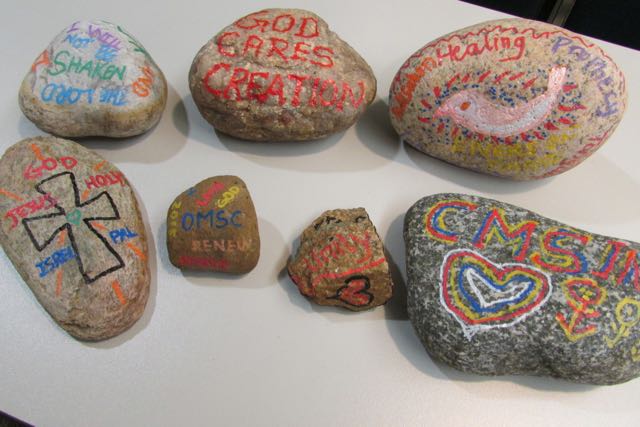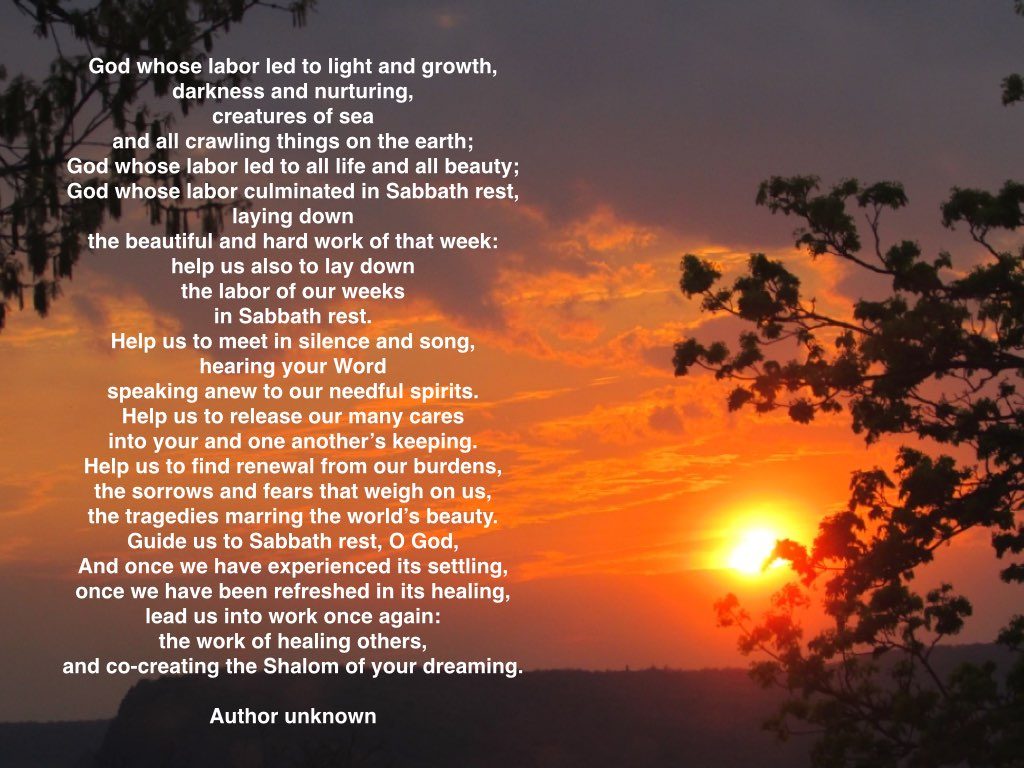
This is the last of my series of posts on sleep and rest. It seems appropriate to remind us that the ultimate rest of all is the rest of God – the Sabbath rest – not a rest of exhaustion at the end of a busy week, but the rest of delight and accomplishment, the rest that says “Well done good and faithful servant”, the rest that looks around at all that has been done and says “It is good”.
This kind of rest in hard to achieve in a world that insists we never have enough – not enough stuff, not enough time, not enough “friends” on Facebook. Our society thrives on discontent and the quest for more. I sometimes wonder if its lack is part of what contributes to our sleeplessness on other days too.
So enjoy this prayer. Read it through slowly, savour it, take it to heart, and create for yourself a Sabbath rest.
————————————————————————————-
Other posts in this series:
On Screen/Off Screen Is It Hurting Our Sleep?
Let Us Rest With God – A Prayer
What’s the Problem With Insomnia

The discussion on Tuesday’s post What’s the Problem With Insomnia has made me realize that this is an extremely important issue for many of us. It is easy to make the excuse however that waking in the night is normal and then ignore the factors in our lifestyles that contribute to our sleeplessness. I wrote about this several months ago and hope that you will forgive me for repeating some of what I said then.
Sleeplessness is often more a function of our lifestyle than anything else. We can’t just blame the electric light however. Lack of time outside in the sunlight, lack of time in the dark at night, lack of exercise, stress and the inability to relax our minds before we go to bed can all contribute to lack of sleep. Inner Body Research has some great suggestions for those who struggle regularly with insomnia, including some simple ways to diagnose what may be the underlying cause of the problem. No wonder the sleeping pill industry is booming.
The problem is getting worse and our technology contributes to it. A few months ago I read this interesting article Reading On A Screen Before Going to Bed May be Killing You.
You’ve heard that using screens before bedtime can mess with your sleep, but new research suggests the problem is even more serious.
Reading from an iPad before bed not only makes it harder to fall asleep, but also impacts how sleepy and alert you are the next day, according to new research from Brigham and Women’s Hospital in Boston, Massachusetts. The study, published in the journal Proceedings of the National Academy of Sciences on Monday, said the findings could impact anyone who uses an eReader, laptop, smartphone, or certain TVs before bed. Read the entire article
This was not good news for me because I love to read before I go to bed and reading on my tablet means I don’t disturb my husband. Even before I get into bed, Tom and I often watch a movie on our TV before we retire – not necessarily good either.
As I have already mentioned, sleep is one of the essential rhythms of life. Without adequate sleep we soon cease to function properly, without any sleep, a condition that is fortunately fairly rare, we will die. Not only does the biphasic sleep pattern I talked about in my previous post seem more natural, there is even evidence that a siesta in the afternoon boosts our memory and cognitive functioning.
Faith and Sleep
Faith practices can also help us relax and enter into that sleep which is indeed a gift from God which as you know is part of the reason that I write prayers for both the morning and the evening. If we want to sleep properly a rhythm of prayer throughout the day can really help.
- In her article Christian Meditation – God’s Gift for Healthy Sleep Deborah Kukal talks about the important part that meditation on psalms can play in helping us relax and sleep. So when you’re struggling in the night, remember David’s words, and let God’s peaceful gift of meditation fill your soul with comfort, and your body with rest. read more
There are other Christian practices that can help too.
- Lectio divina and a reflective reading of scripture before we go to bed is a wonderful way to relax and go to sleep in the presence of God. Intentionally disconnecting from my laptop or kindle at least 1/2 hour before I go to bed and indulging in a meditative practice like lectio divina much a huge difference to my night’s sleep.
- The prayer of examen which helps us to review the day in the presence of God, encouraging us to leave the cares and worries we have encountered in God’s hands, is another wonderful way to end our waking hours. I have done this sporadically over the years and realize I need to reinstitute this practice.
- Breathing prayers which encourage us to breathe deeply and regularly can also be of great value. Evidently many of us spend most of our lives breathing too shallowly and deprive our lungs and other organs of the oxygen we need to remain healthy. More than that it can relieve anxiety, stimulate our immune system and even alleviate the symptoms of trauma. Read more. As you know I love to write breathing prayers and have found them to be wonderful tools for relaxing me.
- Centering prayers provide a way for all of us to sit in the contentment of the moment, shutting out the noise in order to focus completely on God. This is not a practice that comes easily or naturally to most of us which is probably an indication of the stress that we live under. If you don’t know much about this form of prayer I would heartily recommend Basil Pennington’s classic Centering Prayer to you.
- Prayer beads are, for many, a great stress reliever and can be a wonderful way to prepare yourself for sleep. You might like to design your own prayer to say with your beads before you go to retire for the night.
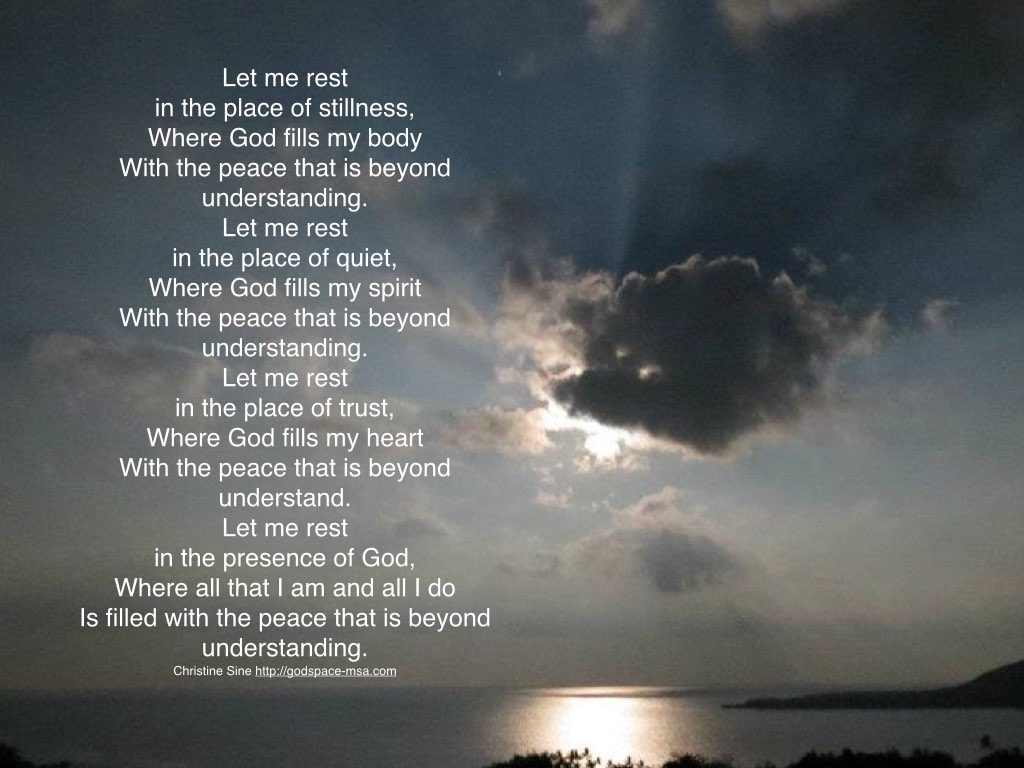 Many Americans are heading towards one of the most unrestful weekends of the year – BBQs and celebrations of July 4th with friends. So I thought that I would post this as a reminder for all of us to take time to rest in the midst of our partying and celebrating – no matter where in the world we are.
Many Americans are heading towards one of the most unrestful weekends of the year – BBQs and celebrations of July 4th with friends. So I thought that I would post this as a reminder for all of us to take time to rest in the midst of our partying and celebrating – no matter where in the world we are.
This prayer is part of a series I am posting this week on rest and sleep. There are the other posts so far:
What’s the Problem With Insomnia
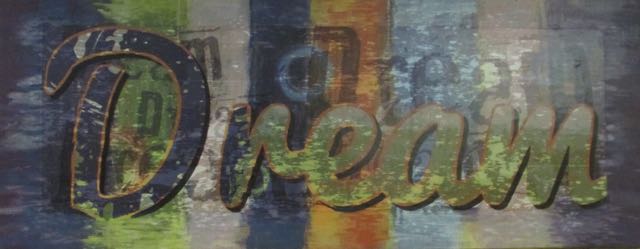
Dream – artwork by Jennifer Hamlett Herrick
Over the last week I have posted prayers to welcome God into our day and into our night. I mentioned that one of these prayers was written as a response to my struggle the night before with insomnia. I was amazed at the number of people who responded with their own stories of sleeplessness and the frustration it caused them.
I have written about sleeplessness before but thought it was time to do a little more research on the subject. What I discovered is fascinating.
According to this article by Natalie Wolchover
More than one-third of American adults wake up in the middle of the night on a regular basis. Of those who experience “nocturnal awakenings,” nearly half are unable to fall back asleep right away. Doctors frequently diagnose this condition as a sleep disorder called “middle-of-the-night insomnia,” and prescribe medication to treat it.
Mounting evidence suggests, however, that nocturnal awakenings aren’t abnormal at all; they are the natural rhythm that your body gravitates toward. According to historians and psychiatrists alike, it is the compressed, continuous eight-hour sleep routine to which everyone aspires today that is unprecedented in human history. We’ve been sleeping all wrong lately — so if you have “insomnia,” you may actually be doing things right.
Normal isn’t really normal at all. According to Natalie and a growing number of researchers, until the invention of the electric light most people slept in four hour blocks, waking in the middle of the night for an hour or two in which they prayed, conversed together, made love or went for walks. Electric light meant we could stay up later. Instead of going to bed for 12-14 hours we suddenly only spent 8 hours or less in bed and expect to get all our sleep done in one go.
Evidently sleeping in the biphasic pattern helps us process our dreams which are part of the problem solving mechanism of our brains. It is no wonder that many people find that their night time wakefulness often ignites creative juices and helps them solve life’s challenges. It also explains why the monastic rhythms began with prayer at 2 or 3 am. This was not some rigourous, aesthetic discipline but rather flowed out of the natural rhythm of sleep and wakefulness. And think about how often in the Bible God awakens prophets and leaders with visions and dreams.
What I wonder are we missing out on because we try to control our sleep patterns? (More to come on this)
What do you think?
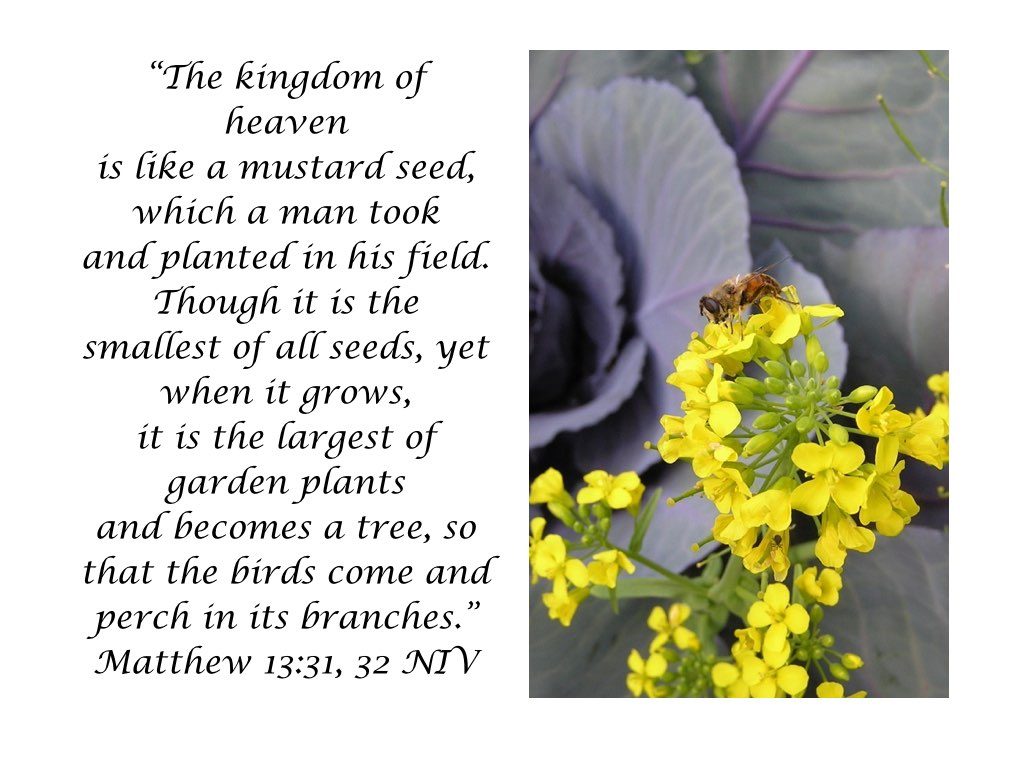 There are many images used in the gospels to describe the kingdom of God – a treasure in a field, a lost coin, yeast. My favourite is the mustard seed – a small seed that grows into a huge plant. Yet in many parts of the world, mustard is a noxious weed, something that no self respecting farmer would plant.
There are many images used in the gospels to describe the kingdom of God – a treasure in a field, a lost coin, yeast. My favourite is the mustard seed – a small seed that grows into a huge plant. Yet in many parts of the world, mustard is a noxious weed, something that no self respecting farmer would plant.
So the kingdom of God is like a weed? How could that possibly be?
When we think about it, the analogy does not seem so far fetched. Weeds are resilient, tenacious, ubiquitous. They emerge everywhere – not just in the garden but unexpected places like the crevice of rocks and through cracks in the concrete. No weed block keeps them out for long. We try to yank them out or poison them but in a couple of months they are back.
Just so the kingdom of God. It is constantly emerging in unexpected places. It cannot be suppressed. In the devastation of an earthquake in Nepal, strangers come from all over the world to help. In the violence and hatred in the Middle East, an Israeli woman protects a Palestinian child. In the presence of injustice, the Rosa Parks‘ emerge to show us the path to truth. Activists work for the rights of women, gays, illegal immigrants.
What is your response.
Go for a walk outside and look at the weeds in your garden (or your neighbour’s garden if you don’t have one). What are the unexpected places in which they are emerging? Now go inside and sit quietly thinking about the unexpected places in which you have caught glimpses of God’s kingdom emerging. Write these down. Each evening this week before you go to bed ask yourself – where have I caught glimpses of God’s kingdom today? Grow your list. Ask God if there is any further response you should make to grow the kingdom that is emerging.

Weeds are important in a garden. They are good indicators of soil conditions and often help improve the soil as they send down roots that grow deep loosening hard compacted soil and bringing up useful minerals from deep down. The Canadian thistle that some try so hard to eradicate, reaches down up to 20 feet for nutrients. It breaks up the soil, enriches it and makes it healthy so that other plants thrive.
Weeds make good cover crops, provide habitats for beneficial insects and prevent erosion. They provide essential food for wildlife, pollen and nectar for beneficial insects, and nutrition for livestock and humans alike. Here in the Pacific NW, blackberries grow everywhere. We want to rid of them, yet they provide a wealth of edible fruit packed full of vitamins.
The kingdom of God is like a weed, it improves the soil of the whole garden of God. It provides nutrients and food, and a protected place for all God’s creatures to dwell.
What is your response.
Sit quietly in the presence of God and think about the people in your life who irritate you, the situations that you wish would go away, the injustices you would rather ignore. Who or what are the weeds in your life or community that represent the kingdom of God? Where have you tried to yank out the kingdom of God from your life or your community because it made you uncomfortable? Make a list.
Now listen to the song below and prayerfully ask God how you should respond.
Spring was exciting, summer is heating up! Although we’ve had a challenging time with the vandalism of windows at our center for imagination and creativity at Mustard Seed Village, we’re not discouraged and we’re not slowing down. So many good things are happening and we want to invite you to join with us in some great opportunities to connect and grow both online and in person.
Just Six Weeks Until Our Celtic Prayer Retreat
Are You Registered?
August 7-9 Main Event All Day Saturday
Reconciliation is at the heart of the gospel message. Through the Holy Spirit, God’s love has flooded our hearts, reshaping and transforming us. We are journeying not just toward renewed relationships and communities, but toward a new creation in which we are all reconciled to the image of God within us, within others, and even within creation.
 Our annual retreat on August 7th-9th is your invitation to enter this journey. With the inspirational 6th century Irish monk Columba as our guide, we will walk together through scripture,
Our annual retreat on August 7th-9th is your invitation to enter this journey. With the inspirational 6th century Irish monk Columba as our guide, we will walk together through scripture,
reflection, worship, and creative spiritual exercises, stirring our imaginations and opening our hearts and minds to the reconciling power of God. There will be plenty of time and space for inner renewal, plus lots of fun, fellowship and food as we journey together toward restoration and wholeness.
We will set aside the busy clutter in our lives and create a quiet space for prayer and renewal as we worship God in a beautiful outdoor cathedral surrounded by maple and cedar trees.
Following the Celtic Christian tradition, this retreat will incorporate the rhythms of work and rest, community and solitude, prayer and biblical study.
camping, great conversations, and morning/evening prayers, friday & sunday
New To The MSA E-School: Spirituality And GardeningWith Christine Sine
Sun. Soil. Water. Perhaps it’s close communion with the elements of our earthly lives that gives many gardeners a deeper sense of God. In this course, Christine Sine offers us dynamic insight into what the simple labor of a gardener has to do with the God who fashioned the first humans from the soil and made a home for them in a garden. Christine offers presentations on the following topics
- God as a Gardener
- Digging and Watering
- Planting and Pruning
- The Rhythm of the Seasons
This course is perfect for those who are seeking deeper understanding and meaning to their work in the garden.
SEE MORE CLASSES IN OUR SCHOOL
New Workshop Available: Gardening With God & Neighbor
With Andy Wade
In our journey of faith we often refer to Jesus’ command to love both God and neighbor. But what does that actually look like when we get home to our private sanctuary from the world?
 As I tore up grass to grow food in our back yard I began to wonder how garden design influences how we encounter God in the garden. Later, after turning our front lawn into a giant garden, my question expanded to, how does loving my neighbor influence the way I create this private space that meets public sidewalk? In this workshop I’ll share more of my journey and the ideas it inspired, give some practical advice for making it simple and cost-effective, and have time for us to share stories and ideas from your own experiences.
As I tore up grass to grow food in our back yard I began to wonder how garden design influences how we encounter God in the garden. Later, after turning our front lawn into a giant garden, my question expanded to, how does loving my neighbor influence the way I create this private space that meets public sidewalk? In this workshop I’ll share more of my journey and the ideas it inspired, give some practical advice for making it simple and cost-effective, and have time for us to share stories and ideas from your own experiences.
Workshop Outline:
- Introduction
- Why garden with God and neighbor in mind? Part of the process of integrating faith into all of life.
- “What If” video
- Gardening with God in Mind
- Stewarding the gift of creation
- Getting out of the box!
- Letting God surprise you
- Discovering and creating sacred pockets
- Gardening with Neighbor in Mind
- Removing barriers and blurring the lines
- Inviting community/fostering hospitality
- Nomads don’t plant fruit trees – Putting down roots
- Fostering friendship through sharing
- A Light and Easy Burden
- Dig no more
- Recycle
- Save the water
Spirituality Of Gardening – A Rocha, Surrey BC
Explore together the beautiful ways that God and God’s story are revealed through the rhythms of planting, growing, and harvesting.
Spiritual insights, practical advice for organic backyard gardeners and time for reflection will enrich and deepen our faith.
You won’t want to miss this opportunity! Join us this fall at A Rocha’s Brooksdale Environmental Centre for our Spirituality of Gardening Seminar lead by Christine Sine of Mustard Seed Associates and author of the book, To Garden with God.
- Time: 9:30 – 1:30pm, lunch included.
- Date: Saturday September 19th, 2015
- Location: Brooksdale Environmental Centre 19535 16th Ave. Surrey, BC V3Z 9V2). Please enter at our new entrance on 192nd Street.
- Cost: $40 includes lunch and Christine Sine’s Book, ‘To Garden with God’.
Contact: Queenie, Garden.network@arocha.ca
I love collecting rocks, and much to my surprise discovered recently that I am not alone. When I ask a group of people “who likes to gather rocks?” probably half of the hands in the room are raised. We pick them up on the beach, beside a stream, along a trail. They remind us of friends, past experiences, places we love.
Unfortunately most of us don’t know what to do with the rocks once we gather them. There are only so many that we can display, and a lot of them look pretty ordinary anyway. Recently however I have started using my rocks as part of my spiritual observances. I paint pictures on them – what I call poor man’s icons. Or I write on them and then use them to decorate my Advent, Lenten and summer prayer gardens. Slowly I am creating a collection of meaningful decorated rocks that I can return to for inspiration time and again.
I find that participants at retreats and workshops also love to write and paint on rocks as the collection above shows and thought some of you might like to give it a go too.
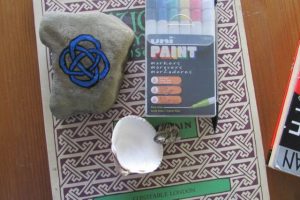
Materials:
- 1 packet paint pens – fine tipped
- 1 pencil and note paper
- 1 rock – smooth as possible
Wash the rock and allow to dry.
Hold the rock in your hand, close your eyes and sit quietly in the presence of the Lord. Is there a special word or phrase that comes to mind? Write it down. Say the word several times slowly. What images come to mind?
Make a rough drawing on your note paper.
Now mark out the pattern on your rock with the pencil. You might want to skip this step if you feel confident in your drawing ability but I have found that marking it both adds to the reflective experience and also produces a better painting
Now have fun with the paint pens. Use plenty of colour. Make this a dramatic statement that will catch your attention when you see it again.
Put it on your desk or in your sacred space and use as a focus for your prayers over this next week. Write in your journal the impressions you have each day as you reflect on the rock. You may like to add to the painting as God prompts you as I did with the image below.
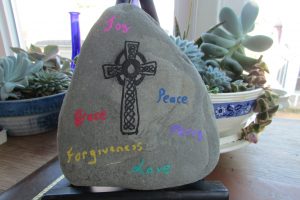
Reflections around celtic cross
This is not the only time I have written about rocks. You might like to check out these previous posts:
As an Amazon Associate, I receive a small amount for purchases made through appropriate links.
Thank you for supporting Godspace in this way.
When referencing or quoting Godspace Light, please be sure to include the Author (Christine Sine unless otherwise noted), the Title of the article or resource, the Source link where appropriate, and ©Godspacelight.com. Thank you!



